Our Verdict
The AMD Radeon RX 7600 has its share of positives, and it offers good value for money for long suffering gamers. However, it doesn't do enough to excite, and it faces tough competition from all sides. We're left wishing the RX 7600 brought a little more to the fight.
For
- Good pricing
- Compact size
- Display support and media engine
- Quieter than expected
Against
- Unexciting performance
- Middling memory spec
- Power consumption is relatively high
- Tough competition - last gen cards are getting cheaper
PC Gamer's got your back
Following the release of AMD's Radeon RX 7900 XT and RX 7900 XTX, you might have expected AMD to follow a traditional release cadence and produce an RX 7800 or RX 7700-series card next. Not this time around. Surprisingly, the second desktop RDNA 3 GPU to be released is the Radeon RX 7600.
After years of massively inflated GPU pricing, is the RX 7600 the card the market has been crying out for? At $269 / £259 / AU$459, the RX 7600 is easily the cheapest of the current generation of GPUs from either AMD or Nvidia though it's important not to overlook Intel's Arc cards either, at least from a value perspective. Nvidia is set to respond with the pricier $299 RTX 4060 in July, so for now, the RX 7600 is touted as being a solid option if you're after a card on a tight budget.
AMD promotes the RX 7600 as a card for mainstream 1080p gamers. Its purpose is to bring competitive performance plus the latest tech and features down to an affordable price point. But don't go expecting wonders from the RX 7600. It's not a magical card that will compete with the top cards of the Radeon RX 6000-series. It's nowhere near. It's best described as an affordable upgrade for mid-tier GPUs of yesteryear. Think cards like the RX 580 or GTX 1060 and you'd be on the right track.
But it's not like RX 6000 or RTX 30-series cards have disappeared. If you have something like an RTX 3060 Ti or RX 6600 XT or better, they are still very capable performers. Current generation options are more limited. The Nvidia RTX 4060 Ti costs a lot more, while on the AMD side, there's a gaping hole in the RX 7000 lineup all the way to the RX 7900 XT.
AMD RX 7600 verdict
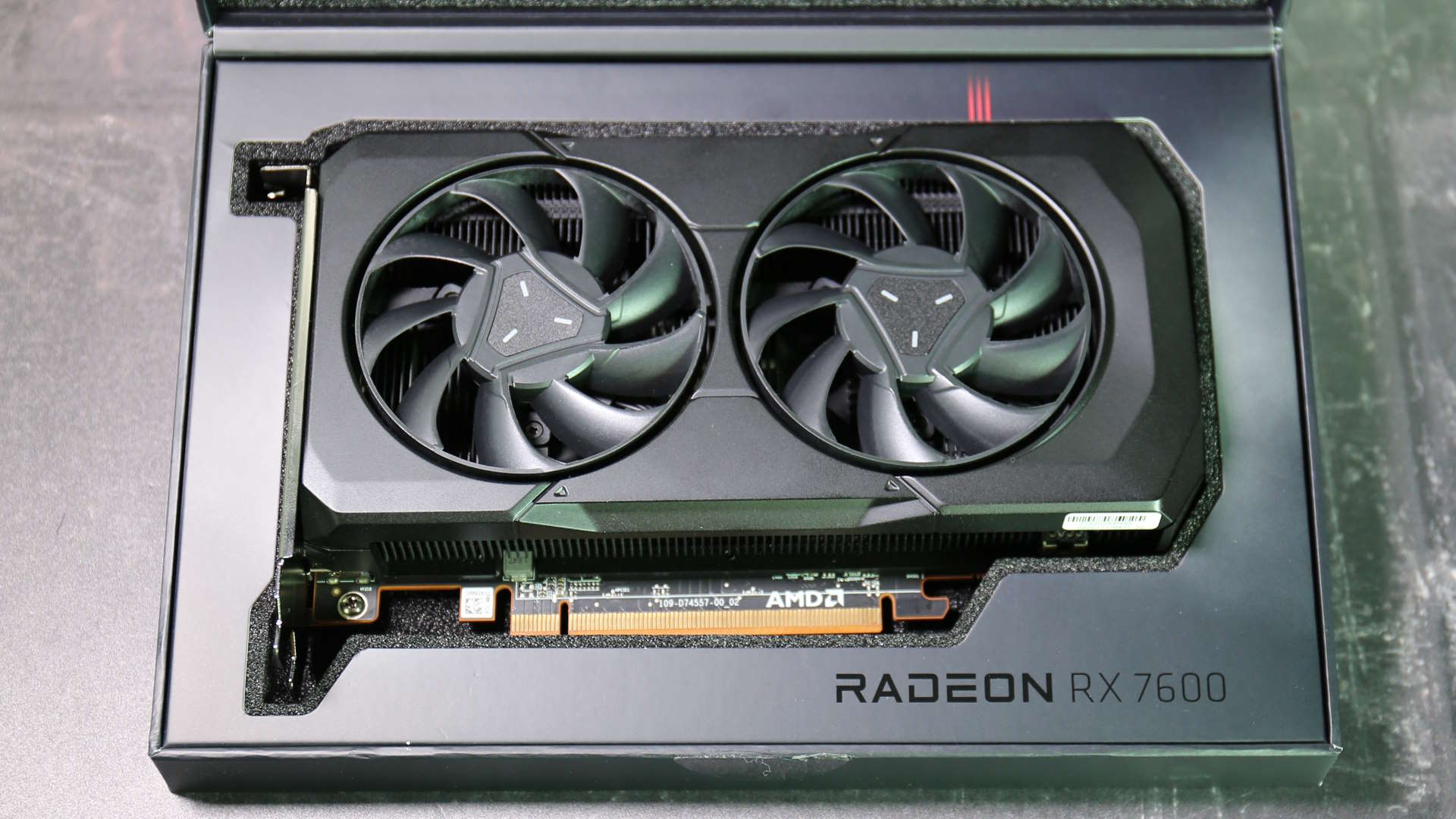
✅ You're upgrading from a card that's a few years old: It's a good upgrade if your aging GPU is struggling to hold playable frame rates in modern and demanding titles.
✅ You're building a compact gaming rig: Thanks to it's tiny size, the reference RX 7600 is a solid choice for a little gaming rig or lounge room PC. It's AV1 encode and DisplayPort 2.1 are nice bonuses too.
❌ You already own a mid range RX 6000 or RTX-30 series GPU. The RX 7600 is very much a card for mainstream gamers. It can't match last gen mid/upper tier cards and its 8GB frame buffer will increasingly become a bottleneck in the years ahead.
I was surprised how small the Radeon RX 7600 reference card is. In fact, it's pretty much tiny compared to some of the triple slot behemoths we've seen. That alone will impress some buyers with compact cases looking to make use of its impressive display capabilities and media engine.
Then there's the elephant in the room. AMD did miss a trick by sticking with 8GB of VRAM. It's enough for 1080p in almost every current game, but can we say that two years from now? What if Grand Theft Auto 6 turns out to be a VRAM hogging monster? 192-bit and 12GB of VRAM would have given the card more appeal and a longer life. We're seeing popular cards like the GTX 1060 and RTX 2060 6GB running into limits now, and there's no reason to expect the RX 7600 won't hit similar limits in a couple of years' time, if not sooner.
But that's in the future. For now, the RX 7600 is a competent, though not stellar 1080p performer. It's easily capable of high framerates in eSport titles and maintaining that important 60 fps level at 1080p in almost every game. It is still the dominant gaming resolution and the RX 7600 does offer a decent all-round upgrade over the aforementioned cards.
There are things I love about the card. It's got a good media engine that includes AV1 encode and decode support up to 8K, DisplayPort 2.1 and support for up to four simultaneous 4K displays at 144Hz each. That makes it a very capable HTPC or productivity GPU. There's nothing available (yet) at its $269 price point that ticks all of those boxes.
AMD RX 7600 specs
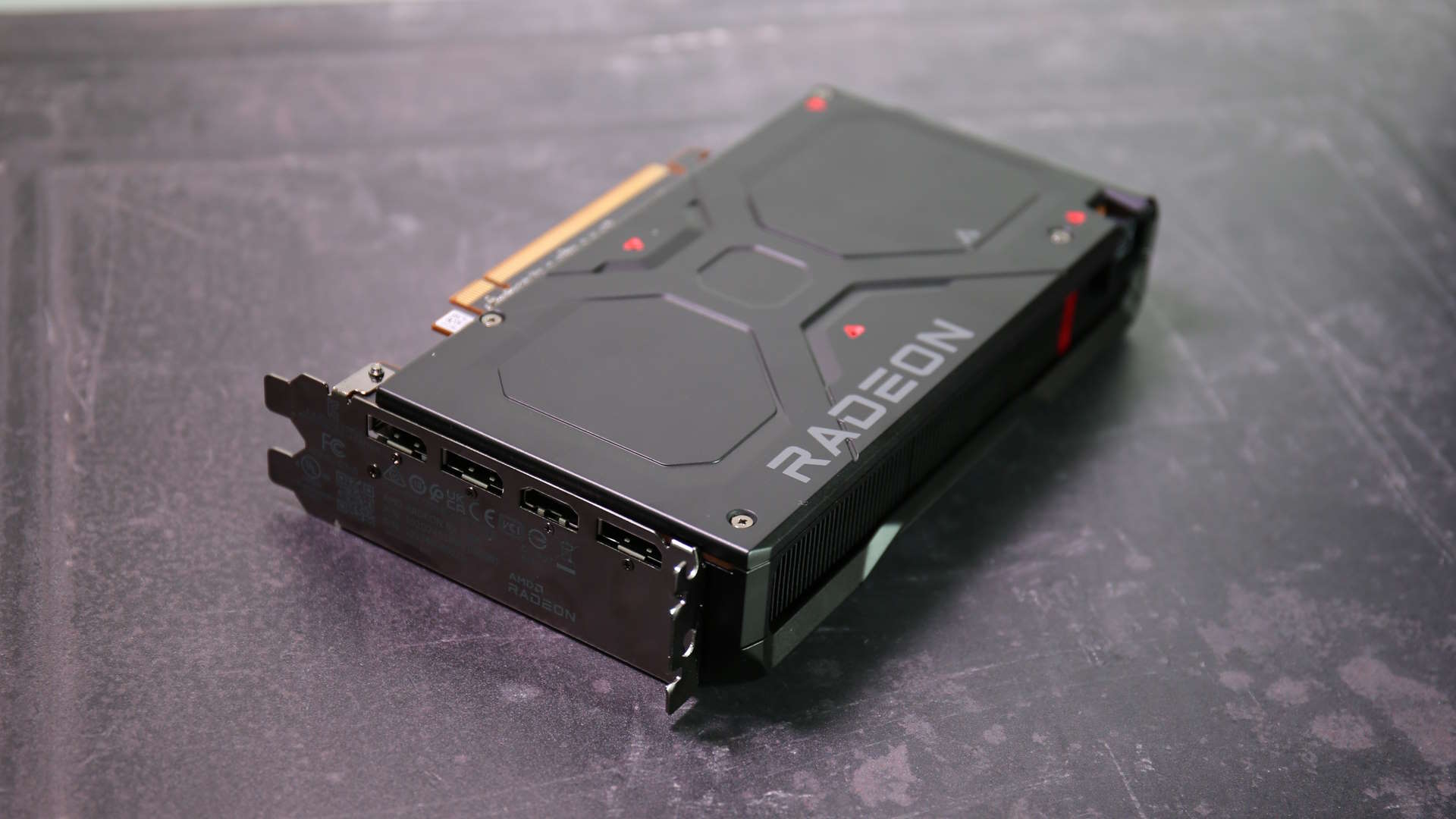
What's inside the RX 7600?
The RX 7600 is the first card to be released with the brand new Navi 33 GPU. Unlike the Navi 31 chiplet design found inside the RX 7900 XT and RX 7900 XTX, Navi 33 is a more traditional monolithic or single chip design. It's built on TSMC's 6nm node, which is a small step behind the more advanced 5nm node of the RX 7900 cards. That's surely for cost reasons.
| Header Cell - Column 0 | RX 7600 | RX 6600 |
|---|---|---|
| GPU | Navi 33 | Navi 23 |
| Architecture | RDNA 3 | RDNA 2 |
| Lithography | TSMC 6nm | TSMC 7nm |
| Stream Processors | 2048 | 1792 |
| Compute Units | 32 | 28 |
| Ray Accelerators | 32 | 28 |
| AI Accelerators | 64 | - |
| ROPs | 64 | 64 |
| Infinity cache | 32MB | 32MB |
| Boost clock | 2,625MHz | 2,491MHz |
| Memory | 8GB GDDR6 | 8GB GDDR6 |
| Memory interface | 128-bit | 128-bit |
| Memory bandwidth | 288 GB/s | 224 GB/s |
| Die size | 204mm² | 237mm² |
| Transistors | 13.3B | 11.1B |
| TGP | 165W | 132W |
| Price | $269 | $329 |
As the RX 7600 is an RDNA 3 GPU, it's got the same fundamental building blocks and microarchitecture as the RX 7900 series models. You can read more about RDNA 3 itself in our RX 7900 XTX review. Compared to the RX 6000 family, you get things like Improved ray tracing, dedicated AI hardware, the updated media engine with AV1 decode support and DisplayPort 2.1.
The RX 7600 comes with 32 compute units. This gives it 2048 shaders units plus 32 Ray Accelerators, 64 AI Accelerators and 64 ROPs. As you can see in the specs shown above, the RX 7600 is a step up in spec from the RX 6600. Both cards come with 8GB of GDDR6 memory over a 128-bit bus, but the faster 18Gbps memory of the RX 7600 gives it a bandwidth advantage, at 288 GB/s compared to the 224 GB/s of the RX 6600.
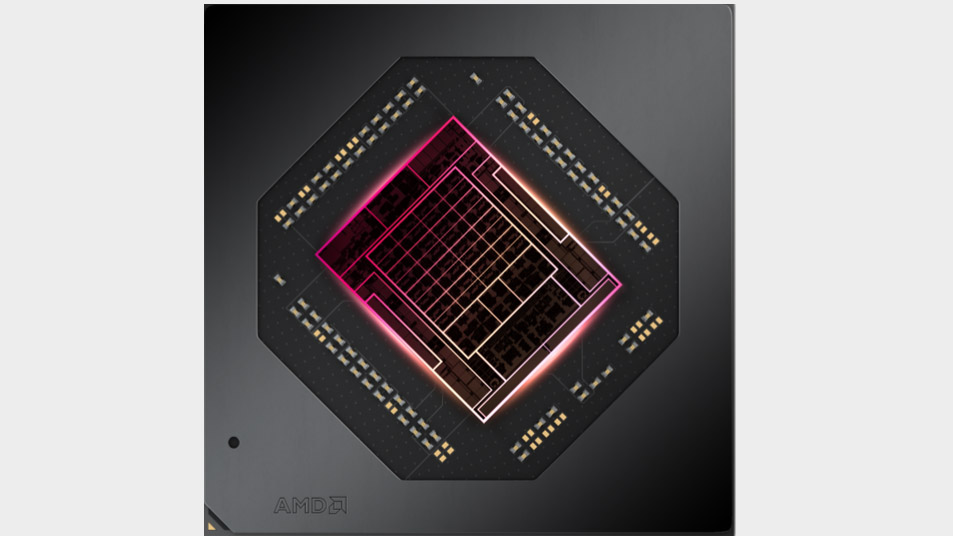
Even though the RX 7600 comes with faster memory and more bandwidth, it's still not a major upgrade. I just can't get used to 128-bit buses on mid range cards. We had 512-bit buses going all the way back to the HD 2900 XT from 2007! There's also the PCIe 4.0 x8 interface. That shouldn't impact performance in any way, at least on a modern system, but sometimes it feels like we're getting graphics cards that have 'adequate' specs, rather than something that makes you sit up and say 'wow!' That goes for all GPU vendors, not just AMD.
The RX 7600 includes 32MB of Infinity Cache, That's an L3 cache that AMD says reduces the need for ultra fast memory. AMD claims this gives the memory subsystem an effective bandwidth of 476.9 GB/s.

As AMD is positioning the RX 7600 as an RX 6600 replacement, it'd be remiss not to mention the increase in power consumption which has increased to 165W, up from the 132W of the RX 6600. It's not a dramatic increase but it is around RX 6600 XT levels and higher than the RTX 4060 Ti, which means it will be higher again over its upcoming Nvidia competitor, the yet to be released RTX 4060. At least the RX 7600 doesn't require a power adapter. It makes do with a single 8-pin PCIe power connector.
On the software side, The RX 7600 supports all of AMD's latest FidelityFX features. The most notable of which is FidelityFX Super Resolution 2, or FSR 2. The latest FSR 2.2 version aims to reduce ghosting and artifacting during disocclusions and its image quality is superior to prior FSR versions.
Sometimes it feels like we're getting graphics cards that have 'adequate' specs, rather than something that makes you sit up and say 'wow!'
We can expect AMD to release FSR 3 at some point this year. It's set to bring its own version of Frame Generation to the table, and is supposed to rival Nvidia's DLSS 3. The RX 7600 is certain to support FSR 3. If you appreciate the extra performance FSR 2 brings, FSR 3 is promised to be better.
It is fair for AMD is keen to portray the RX 7600 as an RX 6600 replacement rather than the RX 6600 XT, but it all depends on the pricing in your region. RX 6000 cards are really dropping in price and the RX 6600 can be found for as little as $200, while the 6600 XT is scraping in at just under the RX 7600's $269 launch price. Interestingly, the RX 7600 was originally to be priced at $299, but there was a late decision to drop that to $269. Make of that what you will.
AMD RX 7600 performance
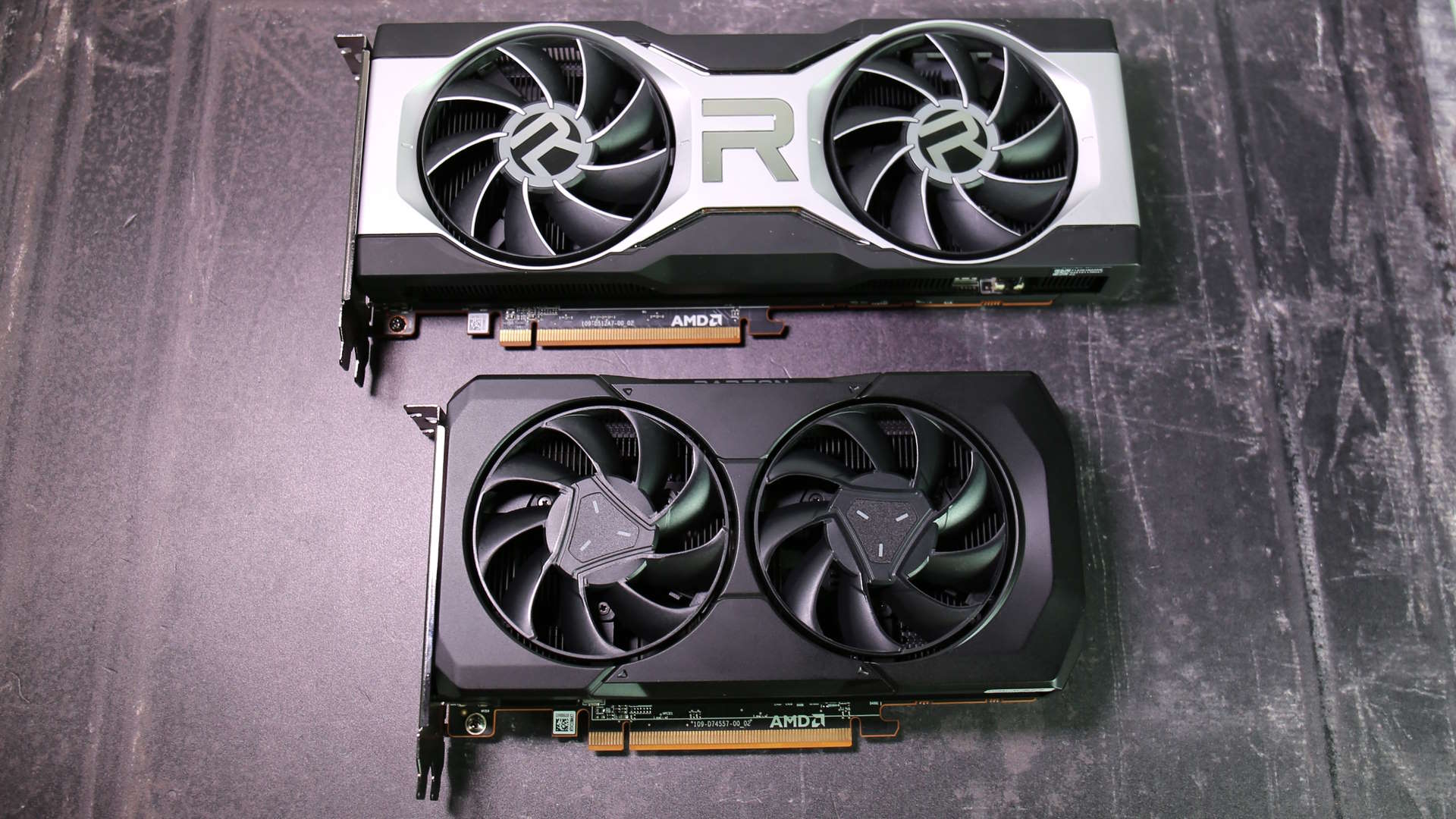
How does the RX 7600 perform?
At $269 for the RX 7600, we obviously aren't dealing with an RTX 4090 slayer. This is a card that is very much mainstream, one aimed at buyers who are more likely to ridicule 7900 XTX or RTX 4090 prices and simply never even consider them.
If you're rocking a high refresh rate monitor, you'll probably have to take a step up to a faster card, to say nothing of running such a monitor at 1440P or 4K resolution.
1080p gaming performance
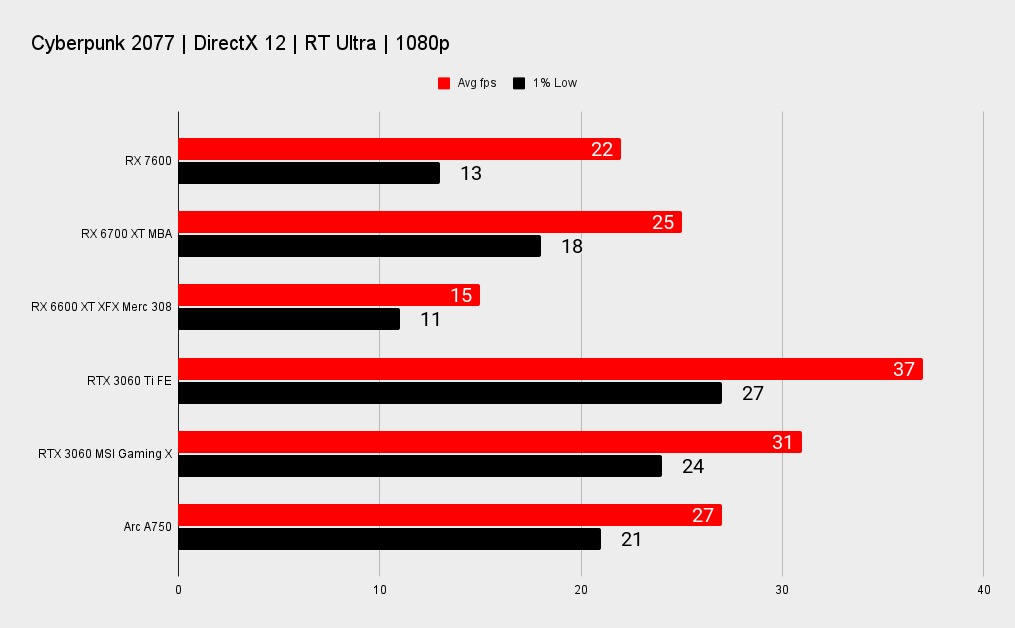
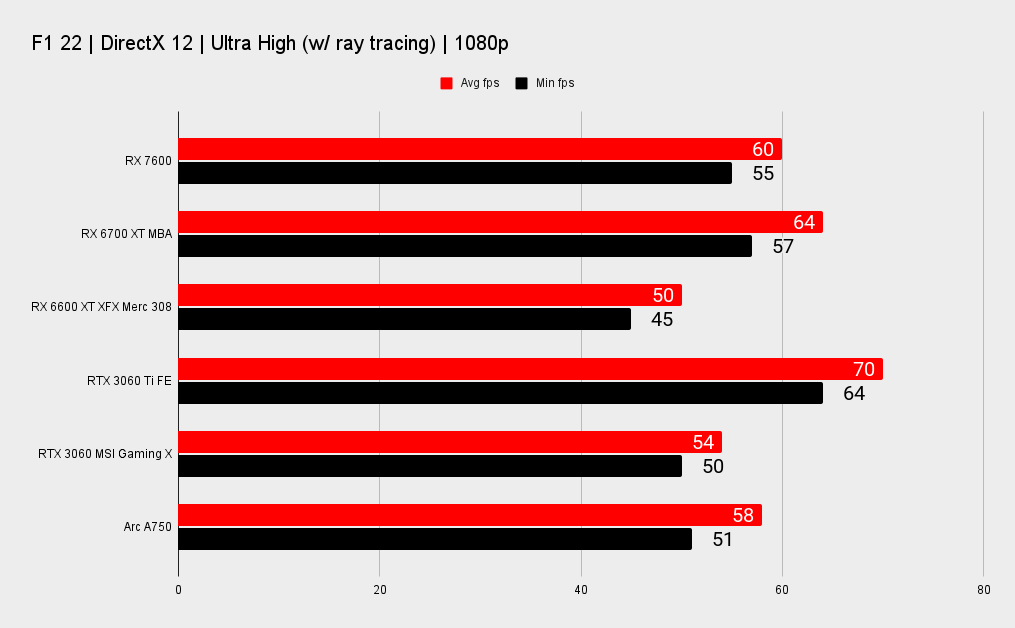
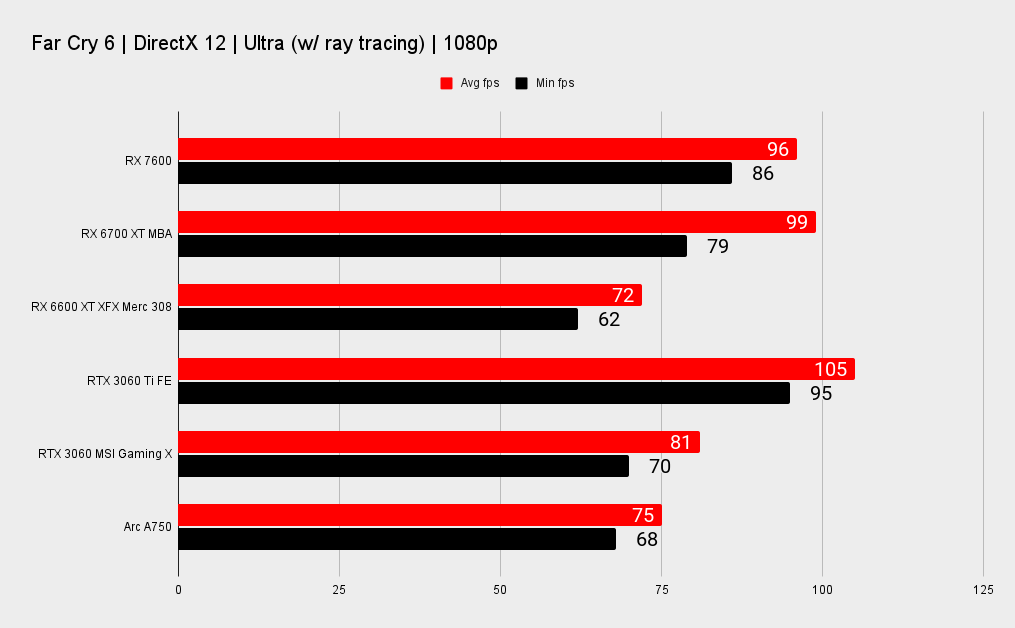


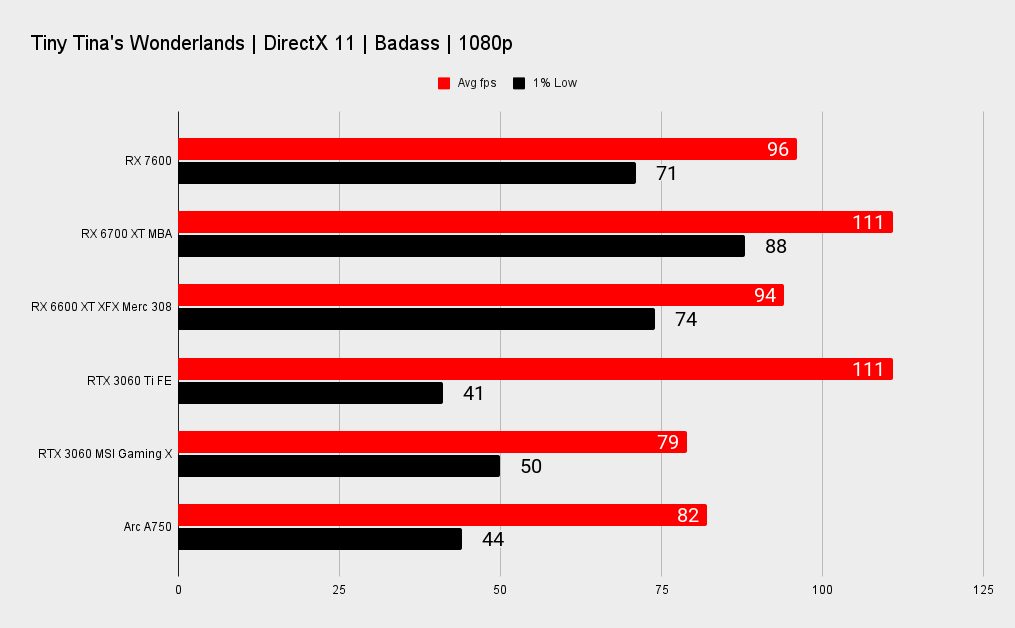

1080p is the sweet spot for the RX 7600. At high settings, with the exception of the ultra punishing Cyberpunk 2077, the RX 7600 is capable of the all-important 60 fps or higher. Less demanding but popular games like DOTA 2 or Fortnite will purr along at well over 100 fps.
Notably, AMD has yet to catch up to Nvidia in terms of ray tracing performance. It struggles to match the RTX 3060 when there's heavy ray tracing involved but generally pulls ahead of it in more traditional raster rendering as we see in Warhammer III and Tiny Tina's Wonderlands. I'd argue that ray tracing isn't all that important on mid range cards that lack grunt anyway.
I've spent a lot of time comparing or contrasting the RX 7600 to Nvidia's offerings, but don't dismiss the Intel Arc A750. Its performance is a bit hot and cold but it's definitely improved since its release and it's now far cheaper than the RX 7600.
1440p gaming performance
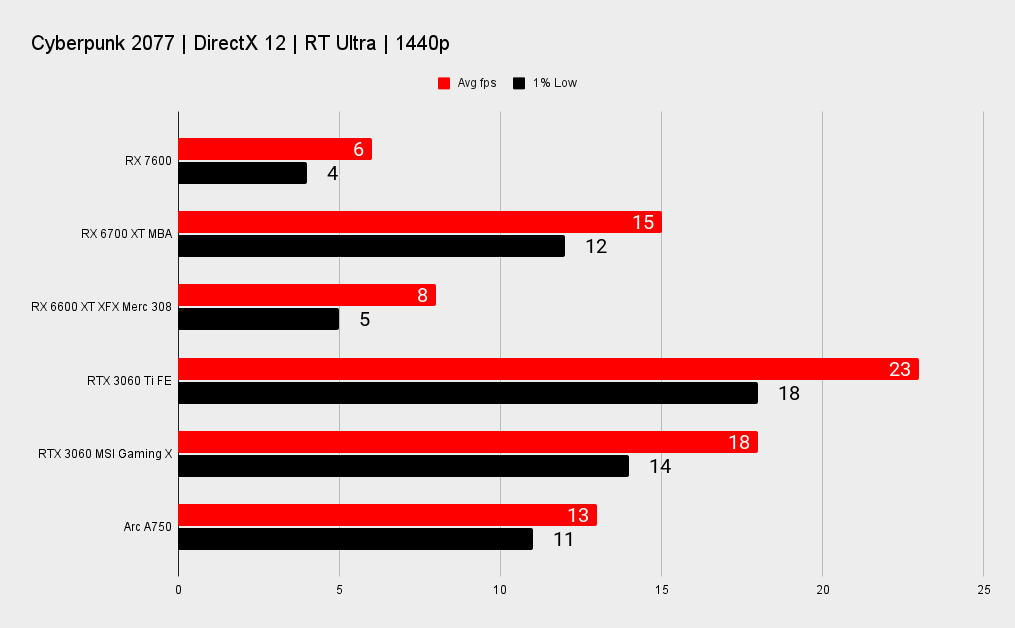
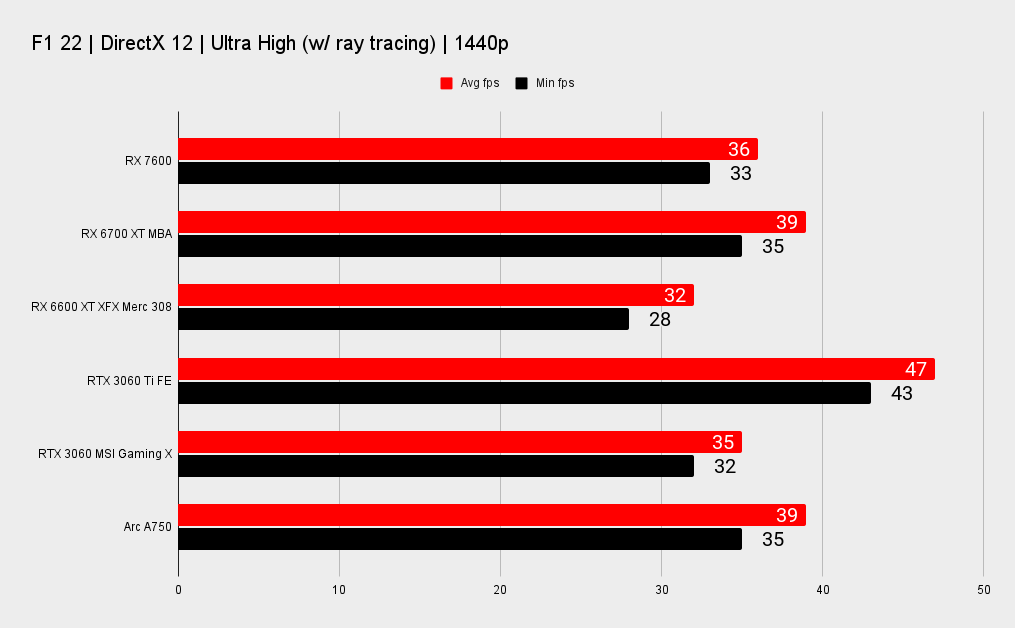

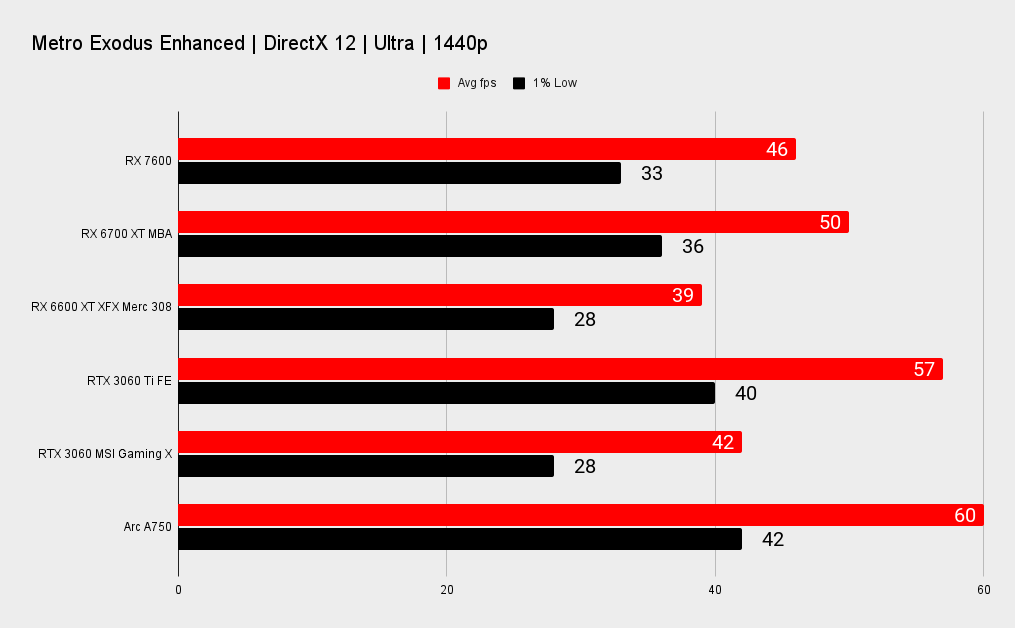
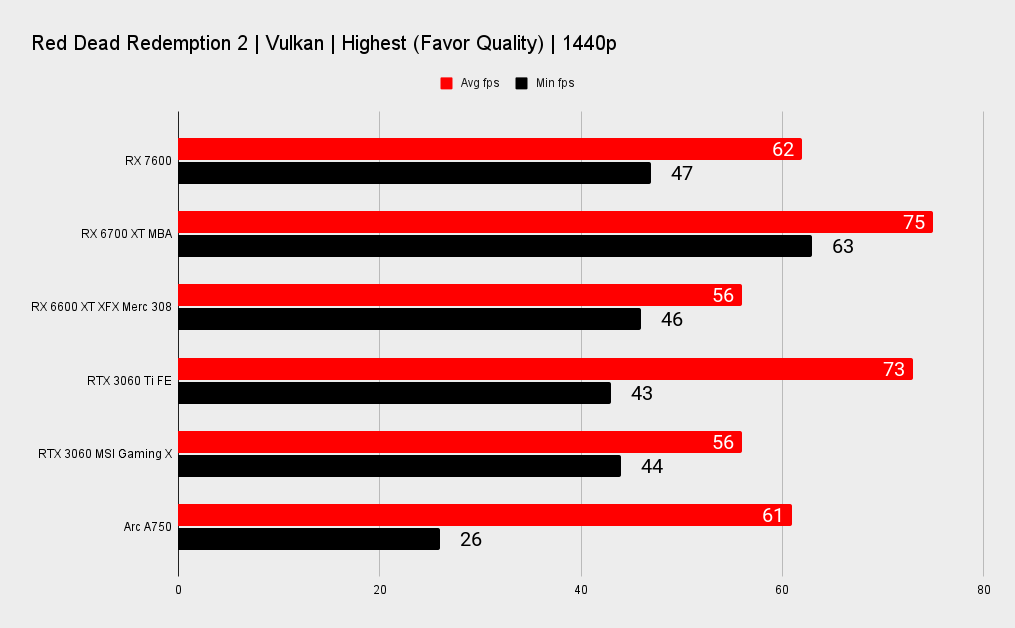
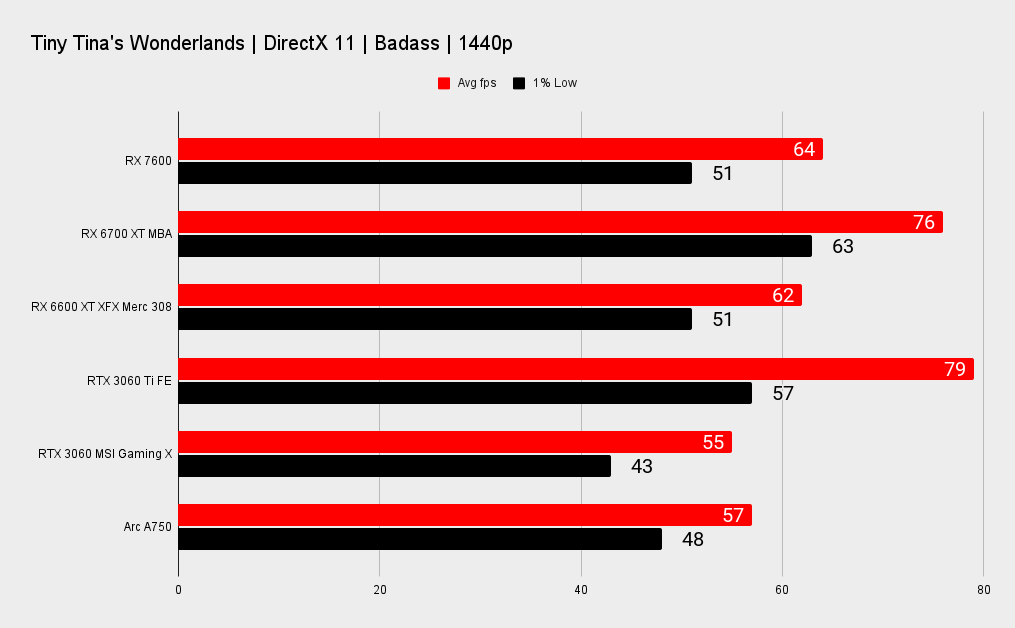

CPU: Intel Core i9 12900K
Motherboard: Asus ROG Z690 Maximus Hero
Cooler: Corsair H100i RGB
RAM: 32GB G.Skill Trident Z5 RGB DDR5-5600
Storage: 1TB WD Black SN850, 4TB Sabrent Rocket 4Q
PSU: Seasonic Prime TX 1600W
OS: Windows 11 22H2
Chassis: DimasTech Mini V2
Monitor: Dough Spectrum ES07D03
The RX 7600 tends to run out of horsepower at 1440p, at least at high settings in demanding games. There's nothing stopping you from dropping the image quality a notch or enabling FSR to boost your 1440p performance though. So 1440p isn't beyond the RX 7600.The likes of Read Dead Redemption 2 and Far Cry 6 hover around that all important 60 fps level.
If you want 60+ fps for high refresh monitors in all modern games, you'll have to take a step up to a better and hence more expensive card. The RX 6700 XT remains a solid option.
FSR performance
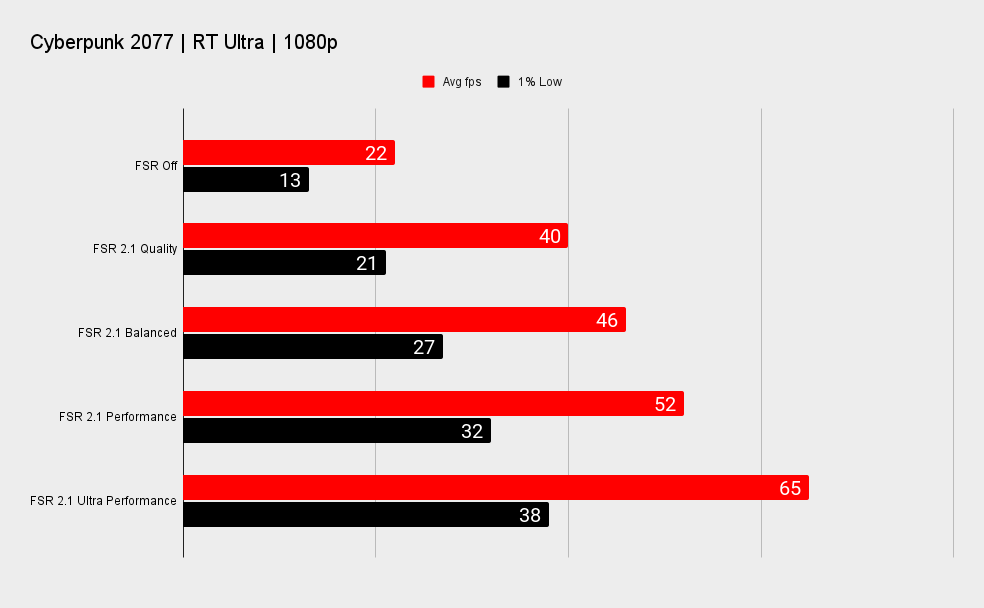

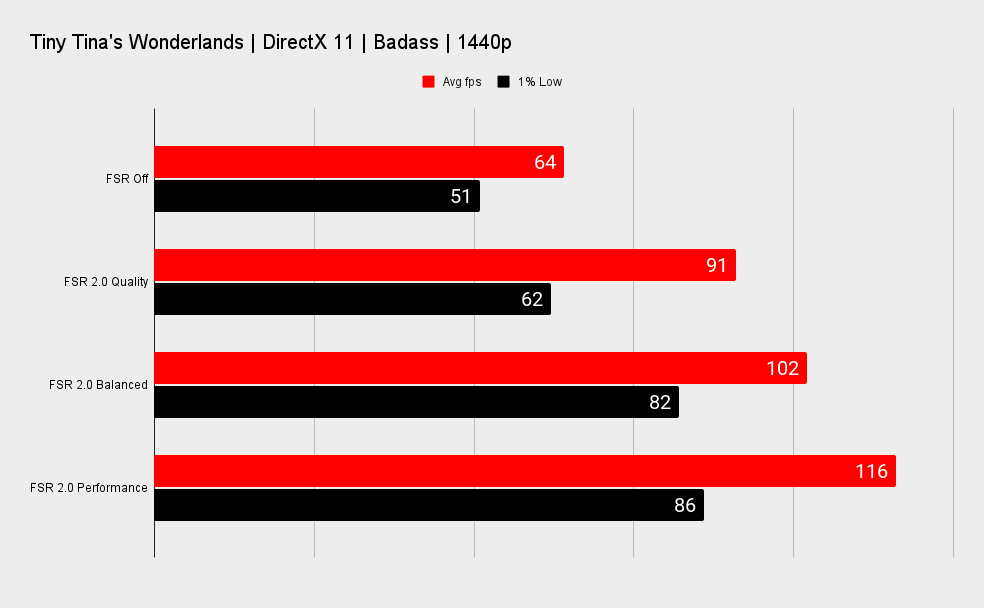
I was especially keen to see how FSR performed on the RX 7600 as it's not far from the threshold of being a capable 1440p card. I mean, if we ignore that Cyberpunk number. FSR, like DLSS, does require individual game support, which is why we don't include upscaling in our standard benchmarks.
But FSR is a great way to sneak some extra performance. If your minimums aren't where you want them to be or you're in that 40-60 fps range with some stuttering in particularly heavy sequences, then upscaling is a tool that you should absolutely try. In fact there's little reason not to enable it these days, and that goes for FSR, DLSS or Intel's XeSS.
FSR doesn't include any sort of frame interpolation yet but in some circumstances it can deliver dramatic performance uplifts. You will get a drop in image quality once you move to the performance or ultra performance modes though.
Maybe I am going blind, but while I'm lining up a headshot or trying to hit the apex of a corner, an aberration or a drop in texture quality here and there won't be noticed anywhere near as much as a sub 30 fps drop would be.
The aforementioned Cyberpunk 2077 is brutal on most cards with ultra ray tracing settings enabled, so to see the RX 7600 hit 40 fps at 1080p with FSR 2.1 set to quality mode was refreshing. That's still not at the frame rate level you'd want it to be, but if you absolutely must enable ray tracing, it is possible to crack 60 fps with the RX 7600 with FSR.
F1 22 saw a major jump in performance too, reaching at least 60 fps at 1440p. Tiny Tina's Wonderlands hits at least 91 fps at 1440p which is a great level if you've got an adaptive sync screen, giving you that nice and smooth gameplay.
System performance

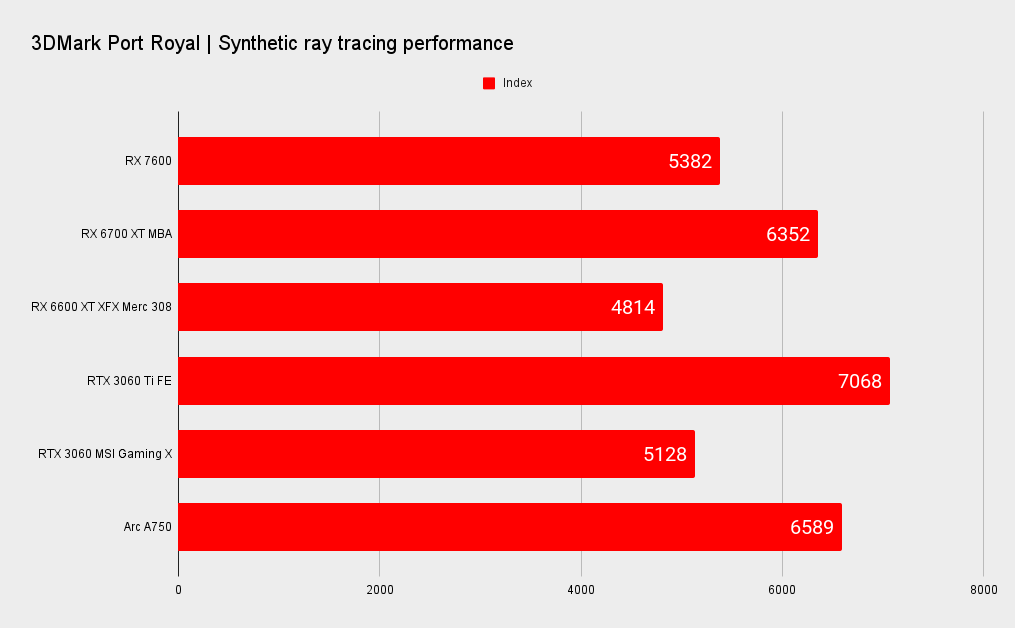
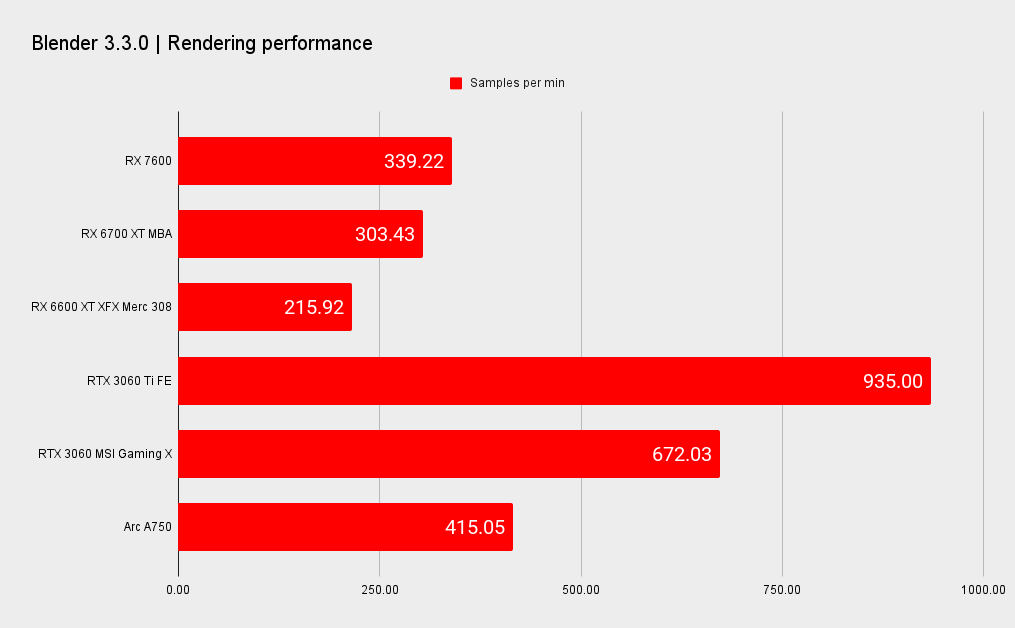




The little RX 7600 ran hotter than I expected but a peak temperature of 72°C is nothing to worry about. You can expect the bigger partner cards to run a lot cooler than that.
It's a quiet card too. At no stage did the fans ramp up to anywhere near a level I'd consider uncomfortable. I'd expect the premium tier partner cards to be effectively silent.
The card was happy to run at over 2,500MHz, but I was hoping for a little more out of it given that clocks like these were common to RX 6600 cards. The jump in power consumption should have allowed it to reach the 2700 MHz+ range. 165W isn't a disastrous number but the performance per watt of the Nvidia Ada generation is tough to beat.
AMD RX 7600 analysis
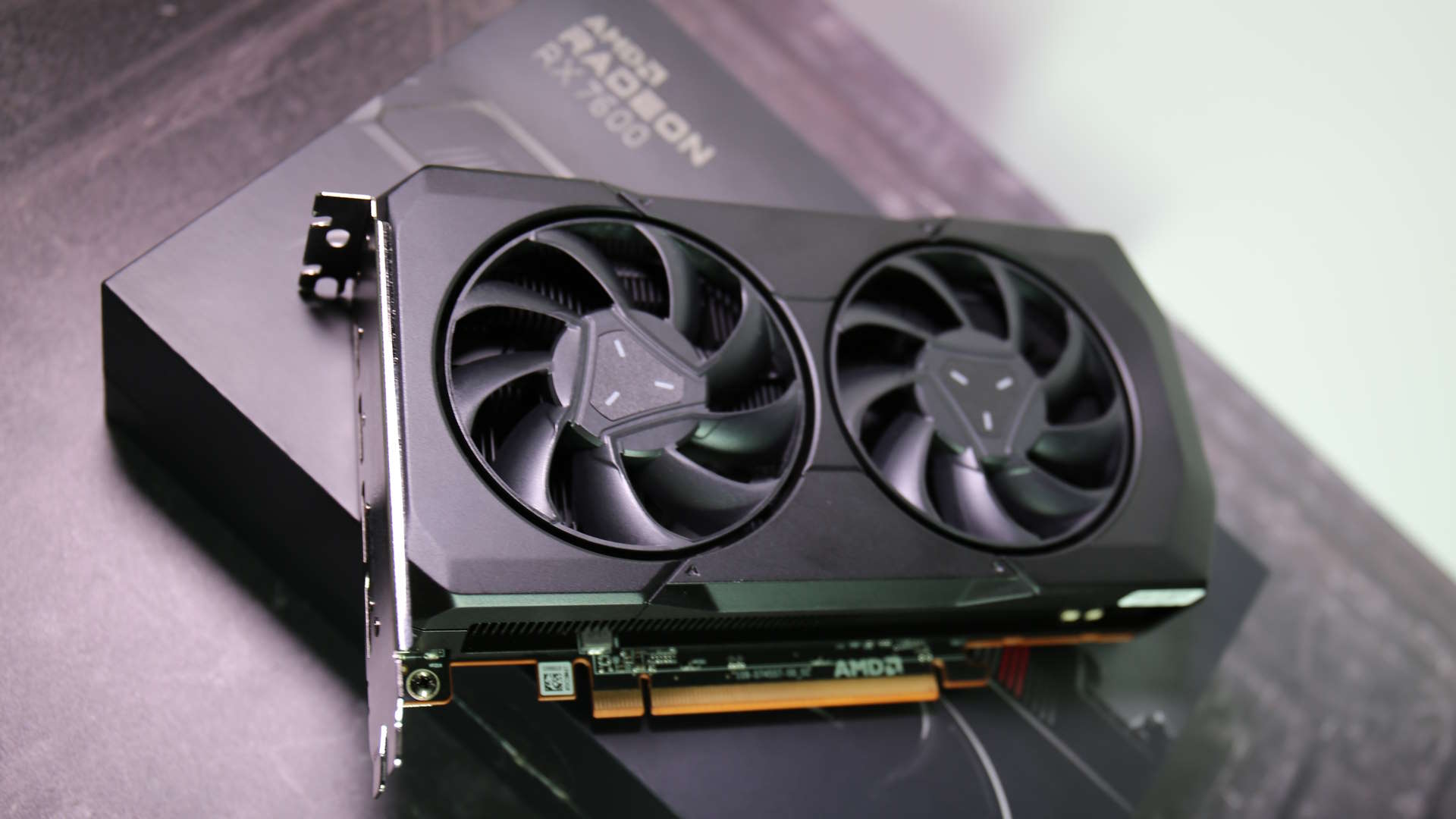
What does the RX 7600 mean for PC gamers?
AMD's choice to release the RX 7600 now seems a little odd. Is AMD running out of RX 6000-series cards? Will we ever see the likes of an RX 7800 or RX 7700? I'd love to be a fly on the wall when the product managers were having their meetings.
On the positive side, the RX 7600 combines some important capabilities and characteristics that will appeal to many users. Its compact size, display support, media engine and value for money will see it end up in many gaming rigs.
But the RX 7600 does not exist in a vacuum. There's competition from many sides. Intel's Arc A750 is one surprising competitor, as are last generation RX 6600 series cards. For a large number of users, the RX 7600 simply isn't a compelling upgrade.
In the years to come, 8GB will become a bottleneck. It's a question of how soon.
Originally I was really worried about the RX 7600 relative to the RX 6700 XT. It's faster than the RX 7600, but on top of that, its extra memory and bandwidth leave it better placed for the mid term future and in some markets, it's available at an enticing price too. I can see examples at $320 in the US, and at the RX 7600's original $299 price, I would have recommended saving a bit more and buying a 6700 XT. However, after the late price drop, the RX 7600 wins back some of its appeal.
I am thankful for that last minute price drop. $269 is a good price for a current generation GPU. At that price it offers long-suffering gamers an opportunity to upgrade after years of miner induced mayhem. The days of $400 entry level cards are gone, and that's a great thing for gamers.

But the cards' performance is best described as adequate, though that's mostly in respect to demanding titles, which not everyone plays. There are millions of gamers out there playing games from a few years ago or esport titles who are looking for a modern card for a good price. The RX 7600 is just such a card.
Now we come to what I consider the card's Achilles Heel. 8GB of memory is acceptable, but for how long? It may be for a year or two. But even now we are seeing 8GB cards run into some limitations. In the years to come, 8GB will become a bottleneck. It's a question of how soon. I've got to commend Nvidia for offering 8GB and 16GB versions of the RTX 4060 Ti. They aren't RX 7600 competitors and the 16GB 4060 Ti is really overpriced, but it'll be nice to have the option if you want it. AMD says it has no current plans to produce a 16GB RX 7600.
The RX 7600 isn't quite the budget hero gamers have been waiting for. Unless you're coming from a GTX card, or something like an AMD Vega, the performance gains may not be worth it. But gaming isn't everything. Its modern features, display capabilities and compact size will appeal to more than just gamers.
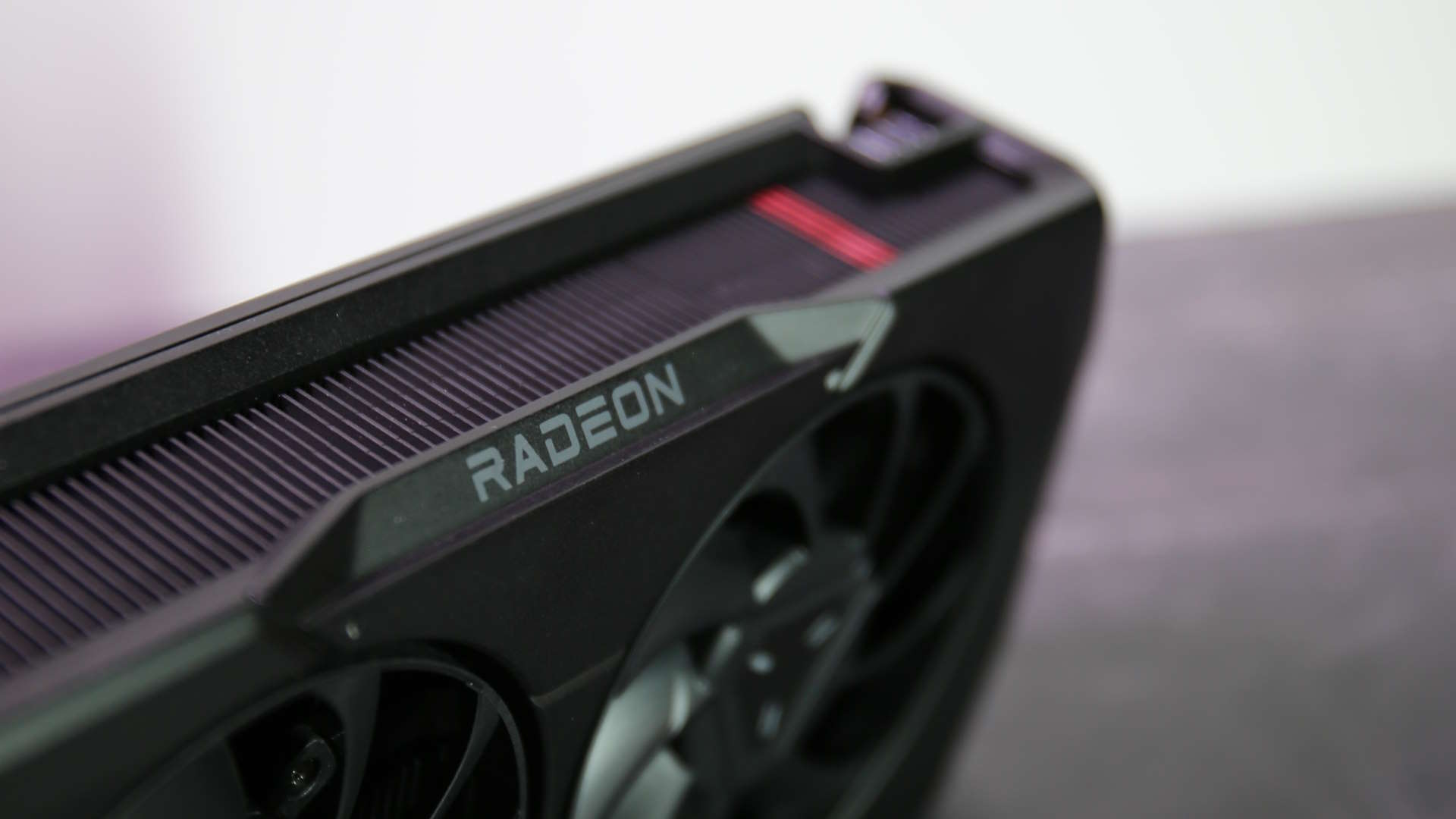
Still, the card still leaves me wishing for a bit more. It doesn't do enough to appeal to RX 6000 or RTX 30-series owners and its 8GB and 128-bit bus will begin to look weak as we move into 2024 and 2025, when the card will still be available.
While I'm not blown away by the RX 7600, it's still a competent offering, and does have its low-end appeal. At $269 it's a welcome addition to the market. It only has to drop a little from there and I might be tempted to call it a cheap GPU. I couldn't have imagined I'd be using the words cheap and GPU in the same sentence a couple of years back, so at least that's a win.
The AMD Radeon RX 7600 has its share of positives, and it offers good value for money for long suffering gamers. However, it doesn't do enough to excite, and it faces tough competition from all sides. We're left wishing the RX 7600 brought a little more to the fight.

Chris' gaming experiences go back to the mid-nineties when he conned his parents into buying an 'educational PC' that was conveniently overpowered to play Doom and Tie Fighter. He developed a love of extreme overclocking that destroyed his savings despite the cheaper hardware on offer via his job at a PC store. To afford more LN2 he began moonlighting as a reviewer for VR-Zone before jumping the fence to work for MSI Australia. Since then, he's gone back to journalism, enthusiastically reviewing the latest and greatest components for PC & Tech Authority, PC Powerplay and currently Australian Personal Computer magazine and PC Gamer. Chris still puts far too many hours into Borderlands 3, always striving to become a more efficient killer.


